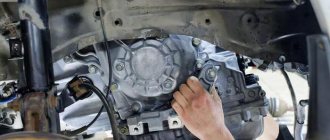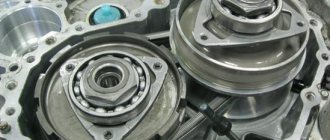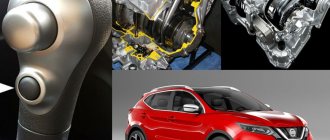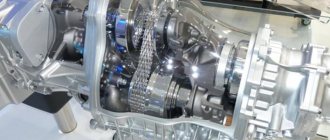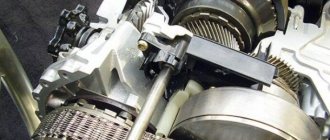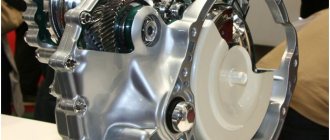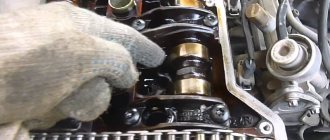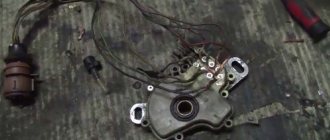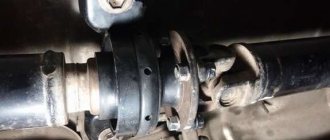The main problems with the Nissan x Trail CVT engine arise due to incorrect driver behavior. Most often they get used to a different type of gear shift. Problems arise when the box is handled carelessly. The Nissan X Trail allows the driver to shift gears more smoothly and start the engine without pre-warming in the cold. To prevent premature repair of the variator, you must carefully study the technical manual.
If the variator is under warranty, then you need to contact only a specialized service center. If it already falls under the warranty period, then repair or replacement of Nissan X-Trail parts can be carried out by our experienced craftsmen. Ignoring the problem leads to serious damage and a major increase in the cost of repairs. The Nissan Trail T31 and T32 SUVs are equipped with Jatco CVT gearboxes. They are reliable and can work in any conditions.
General characteristics
Below are the main characteristics of the Nissan Trail variator for the T31:
| Power level | 141 hp |
| Fuel type | Petrol |
| Consumption per 100 km | 10,6 |
| Acceleration up to 100 km/h | 11.9 sec |
Characteristics for T32:
| Power level | 144 hp |
| Fuel type | Petrol |
| Consumption per 100 km | 11.2 l |
| Acceleration up to 100 km/h | 11.1 sec |
In terms of their design features, both CVT boxes have a similar structure. It is for this reason that repairs are carried out according to uniform regulations. The only difference is the difference in clearances, so when purchasing new parts you need to study the markings. This information is indicated by the manufacturer on the packaging for Nissan x Trail spare parts.
Engine design
The RE0F06A variator on the Nissan x Trail consists of a V-belt drive. This detail is the main one. The gear ratio of the gearbox changes by changing the distance between the driving and driven pulleys. The box includes planetary gears, which are used to regulate the reverse gear.
To understand what repairs may be required on the Nissan Trail, you need to study the design features. The main components of the T31 and T32 CVT include:
- variator pulleys;
- steel belt;
- solenoids, box valves;
- reverse clutch packages;
- control unit;
- high pressure pump.
The gearbox pulley is connected to the clutch motor. Both modifications have the same design. When choosing spare parts, our specialists choose based on the recommendations of the Nissan Trail manufacturer.
general information
A CVT or CVT gearbox is a device that smoothly transmits torque from the power unit to the wheels. In this case, the gear ratio can be changed automatically according to a preset program or manually.
Taking into account the fact that this type of box does not have variable gears, the change in gear ratios occurs evenly, without jerks or jolts. The same feature of the CVT transmission ensures a smooth acceleration, higher engine efficiency and, as a result, reduced fuel consumption.
The most common types of CVT configurations used in cars are:
- V-belt;
- toroidal.
V-belt variators are the most popular type of device, used in most models of modern cars. Their main structural elements are the driving and driven sliding pulleys, united by a special belt (a V-chain with a trapezoidal cross-section). Changing the gear ratio in such devices is achieved by changing the diameter of the pulleys. At the start, the driving pulley has a minimum diameter, the driven pulley has a maximum. This allows for the highest gear ratio. As the speed of the power unit increases, the diameter of the drive pulley increases, and the diameter of the driven pulley decreases, which, as a consequence, leads to a decrease in the gear ratio.
Toroidal variators use a different operating principle. Their main functional elements are two (driver and driven) coaxial disks with toroidal surfaces, between which the rollers are sandwiched. In devices of this type, changing the gear ratio is achieved by changing the position of the rollers. The rotational moment is transmitted due to friction forces arising between the disks and roller elements.
Weaknesses of CVTs
Repair of the Nissan T31 variator begins with replacing the clutch that blocks the hydraulic transformer. Consumables include oil seals, oil seals and gaskets. These are mandatory elements that need to be changed during a major overhaul.
When the cause of the breakdown is the hum of the box, you need to change the pump valve, belt and pulley bearings. The most common malfunctions and the reasons for their occurrence can be identified:
- Step motor. This part is responsible for the gear ratio and the distance between the cones. If a malfunction occurs, the variator does not change speed. Malfunction in most cases occurs due to overheating or exhausted service life.
- Valve in the oil pump. A typical situation for the JF011E is the failure of this part. If a breakdown occurs, the oil pressure level begins to drop sharply, the belt and clutches slip. To fix the problem, you need to install a valve with a larger diameter. The seat is processed by a reamer.
- Torque converter. For the X-Trail T32 variator it is sold assembled.
- Gaskets. When replacing, you need to buy a complete set. Transtek even offers large Teflon rings in the kit. Their thickness is 2.5 and 3 mm.
- Shaft bearings and belt. The cause of the malfunction is overload and slipping when the belt is completely worn out. If an extraneous hum and vibration appears, you must immediately repair the Nissain Trail variator and replace all 4 bearings.
If you do not ensure timely repair of the Nissan X Trail variator, there is a possibility of damage to the cone rollers and other important components and parts. More major repairs are costly. If you do not undergo a technical inspection, you may encounter complete damage to important parts and components that will not be repairable.
What causes a variator to break down?
The main cause of known malfunctions of CVTs is violation of basic operating rules:
- the oil or filter element was not replaced on time;
- use of low-quality oil;
- aggressive driving style;
- prolonged driving at maximum speed;
- sudden braking.
Additional causes of malfunctions can be various defects in structural components (defects, ill-conceived design, poor-quality connection), as well as natural physical wear and tear of the constituent elements, which manifests itself after 150,000 - 200,000 km.
CVT malfunctions can occur both in its electronic control module and in mechanical components.
Electronics defects
In the first case, detection of a specific breakdown is carried out using computer diagnostics. A diagnostic code is assigned to each defect. Thus it is easy to determine:
- problems with the electronic control module board;
- defects in the speed sensors of both pulleys, operating oil temperature, pressure in the main line or pulleys;
- malfunctions of the stepper motor, defects in the blocking valves of the hydraulic transformer and control of the operation of the planetary gearbox, solenoid valves for pressure in the main line and the driven pulley.
The probable cause of a defect in the electronics may also be a violation of the integrity of the electrical wiring or unreliable contact in the connector.
Mechanical problems
Computer diagnostic tools are not the only tools used to detect mechanical problems. In this case, it is necessary to approach the problem in a comprehensive manner and monitor the parameters of the working fluid, conduct road tests, read the diagnostic code, and clarify signs of malfunctions.
Checking the operation of the variator
When performing any repairs to the variator, it must be checked for serviceability and performance. It is necessary to carry out diagnostics even after changing the oil. No one can deny the human factor, that even with perfect assembly, errors may remain.
To check the operation of the variator after repair, it is necessary to set the selector to the neutral position and start the engine. Next, the lever is passed through all ranges. Switching should be smooth, without any effort on the part of the inspector. If there are no problems, you can proceed with a test drive.
You need to start driving after repairing the Nissan X Trail variator carefully and smoothly. Don't put too much pressure on the gas pedal. When all breakdowns are identified and corrected in a timely manner, the correct oil is filled in, then there will be no jerking, extraneous noise or hum.
Signs of repair
Driving in a faulty car leads to the mechanical part of the Nissan X Trail CVT beginning to deteriorate. Improper handling of the car is indicated by complete wear of the bearings, complete damage to the belt, clogging with metal dust and particles, and overheating. Other characteristic signs can be identified when variator repair is urgently required:
- Slipping. It occurs out of the blue when trying to move away.
- Reduced engine power. A characteristic engine hum appears, as if operating in neutral gear, if you press the gas pedal.
- Spontaneous braking of the car. This is a sign of serious problems, so urgent diagnosis and repair of the variator is required. A breakdown indicates a mechanical failure.
- Light signal on the dashboard control panel. It demonstrates the emergency operation of the gearbox. This is a direct sign of problems with the variator, when you need to urgently contact a service center.
- Noise. If any extraneous noise occurs, the variator must be repaired.
- Gearbox vibration. This is another characteristic sign that the mechanical part of the Nissan X Trail engine is worn out.
- Shocks when changing gears. They occur when the variator is clogged with metal dust or particles. If there is a sign of breakdown, call us, our technicians will help with repairs.
These are the main and characteristic signs that there are problems in the variator. It is important to remember that they must be repaired in a timely manner so as not to damage other mechanical parts.
Detection of defects by external manifestations
Many variator malfunctions can be identified by characteristic external manifestations, but such “diagnosis” has one significant drawback - the manifestation of different defects may be the same. This is reflected in the table below.
| External manifestation | Problems |
| There is no movement; weak dynamics (slippage) | · breakdown of the main clutch; · defective variator transmission; · torque converter problems; · breakdown of the electro-hydraulic system; · problems with the control module. |
| Push when changing neutral to D (R); intermittent movement | · breakdown of the pressure solenoid valve in the main line; · problems with the control module |
| The car is moving in neutral | · the gear selector is faulty; · problems with the control module; · defective wiring or connectors. |
| Manual gear shift does not function | · problems with the control module; ·damaged electrical wiring or connector contacts; The gear selector is faulty. |
The most serious and materially costly defect of the above is the defect of the variator transmission. It occurs when the belt slips between the pulley cones with the simultaneous formation of scoring at the ends of the belt segments and the working surfaces of the cones. This problem can only be eliminated by complete replacement.
Diagnostics
Self-diagnosis can only be carried out visually. To check the Nissan x Trail T31 2.5 CVT, you need to get behind the wheel and drive off. If the start is smooth, there is no extraneous noise, then the variator is in technically sound condition. These recommendations apply to the T32 CVT gearbox.
Growling and extraneous noise indicate that the package is not working correctly or has defects. It is necessary to additionally check the oil level of the Nissan X Trail variator, the smell and color of the liquid. For a more comprehensive and accurate diagnosis, you need to contact our center. Employees perform a free check of the condition of the Nissan X Trail variator. By contacting experienced craftsmen, you can quickly check the performance of the part and not be afraid that mistakes have been made.
Appearance and body
The design of the rear is too simple compared to the front.
The X-Trail T32 was created on the Common Module Family platform of the Renault-Nissan alliance. This is also due to the lack of continuity in appearance; now the X-Trail is a stylish modern youth crossover. There is no brutality, no off-road appearance, no overly large arches, no vertical lights.
At first glance, the front design seems overloaded. The photo shows four lines on the hood leading to a V-shaped chrome insert surrounding a large Nissan logo. The front optics are not of the usual shape; some of the corners of the headlights are rounded, others are pointed. And the line of daytime running lights is broken, but looks good.
Nice color. How are you?
The front design of the X-Trail T32 is divided into two levels: headlights on top, a pseudo radiator grille, fog lights and a real grille on the bottom, with a front bumper line between them.
The appearance of the rear part is much simpler: there are not so many lines and textures. The taillights are located on the fenders and on the wide tailgate. Their design is simple compared to the headlights. Also on the fifth door there is a chrome logo, and under it, made of the same material, a stripe above the number. The reflectors and fog lamp are located at the very bottom of the painted plastic trim.
Nissan X-Trail T32 and T31
The wheel arches and sills are also covered with a black plastic casing. Alloy wheels with an unusual design to match the appearance of the front end.
Malfunctions
Two variants of the Nissan x Trail CVT T31 and T32 have almost identical breakdowns. But it is important to pay attention to certain differences. In T31, the weak point is the pressure reducing valve, which is located in the oil pump. It wears out as a result of complete wear and tear of the entire structure of the Nissan X Trail variator. In this case, a large amount of metal shavings and dust sticks to the seat. As a result, jamming occurs during operation. If you feel such signs, then call our service center.
Third generation T32 devices are made on the platform of their progenitors. As for breakdowns, they arise in a similar way. But it is important to say that during production there was a reduction in cost. The complicated control system has a negative impact on the overall service life of the variator, so repairs are required 2 times more often. The advantages include their maintainability and low cost of major repairs.
Frequent breakdowns include problems with the valve body. In order to reduce the cost of the overall design, the manufacturer deteriorated its quality.
Disassembly ABW.BY. What breaks in a Nissan CVT and what can be done to avoid it?
The continuously variable transmission RE0F10A (JF011E), often also referred to as a Nissan CVT, was to be the subject of our disassembly. The point is not that it was installed not only on cars of the mentioned brand, but also on a number of models from Renault, Citroen, Peugeot, Mitsubishi, Dodge, Jeep and some other automakers, which makes RE0F10A the most common among CVTs.
The main reason for the interest in RE0F10A is that experts estimate its service life to be no more than 200-250 thousand km, which means that sooner or later the owners of cars equipped with this variator will have to solve the problems that have arisen in it. The limited resource makes the questions relevant: what and why does the RE0F10A fail, what should the owner do to avoid sending the variator for repair ahead of schedule?
To demonstrate the device and the “sores” of the RE0F10A, we took the Nissan X-Trail variator. So that no one is confused about why it is so clean outside and inside, let us explain that this variator was removed from a car whose owner contacted the service station with a complaint that the car did not pick up speed when accelerating. After washing, diagnosing and calculating the cost of repairs, the owner decided not to repair the box, but to look for a replacement, after which the variator became, if you like, a teaching aid.
Torque from the engine is transmitted to the variator through a torque converter. Wear products from its blocking can affect the durability of the variator, but since this unit is no different from the torque converters of other automatic transmissions, in order not to repeat ourselves, we refer those who want to familiarize themselves with its structure and possible problems to the article published in the newspaper “Autobusiness” No. 7 dated February 20, 2014 “Hot bagels - get your rubles ready.”
We begin disassembly by removing the torque converter and its casing, also called the front cover, with which the variator is attached to the engine.
After removing the cover, the power take-off gears for organizing all-wheel drive, which will not be in the RE0F10A versions for front-wheel drive vehicles, the differential, the main gear and the oil pump drive, become accessible for inspection.
Here you can also see the variator control mechanism, which the driver acts on by moving the selector in the cabin.
From what we saw, the only potential weak point can be called the pump drive chain, which can stretch over time. However, according to the specialists from the KINERGO technical center, who helped us deal with the Nissan variator, the service life of the chain is so much longer than the time when much more serious problems arise in the variator that the oil pump drive is actually only a potential, but not manifested, weakness of the RE0F10A.
The oil pump is another matter. There is a real pitfall in it that you won’t see until you disassemble the pump.
Vane type pump. There are no complaints about its reliability.
The weak point is the pump pressure reducing valve. It functions as a fuse, which limits the amount of pressure created by the pump to the required level. If the valve is stuck, the pressure may be higher than permissible. If the valve spring breaks, the oil goes to drain, which leads to insufficient oil pressure. Both are bad.
Now let's see what's under the stator cover.
Drums with planetary gears and clutches are located here.
Something similar can be seen in hydromechanical automatic transmissions, but in CVTs there are only two gears - forward and reverse. There are no other gears in the sense that drivers understand them in CVT gearboxes. It’s not for nothing that they are called continuously variable, as well as CVT (Continuously Variable Transmission).
Unlike manual transmissions and hydromechanical automatic transmissions, a variator allows for an infinite number of gears. We'll see how this is done, but for now let's pay attention to the clutch package. This is also a weak point.
The color of the linings on the friction rings is alarming: one is black, the other is light brown. The black pad is more worn, and its color indicates that it was overheated, or, as the pros say, burnt.
In fact, she had reached her breaking point. But why? For various reasons, but primarily due to wear, the linings stop holding and begin to slip. This generates a lot of heat. The temperature in the contact zone increases significantly, as a result, the material of the linings burns and turns black.
Slippage is also indicated by the characteristic bluish burns that appear on the working surface of the steel rings of the package, and dark varnish deposits on their teeth.
It is possible that the ring whose linings are still of normal color may have slipped. It simply came into contact with a large mass of metal, which took away excess heat. In any case, the clutch pack must be replaced.
Still, we haven’t seen the main thing yet. Therefore, we turn the box over and remove the back cover. Why wasn't this done right away? To show the disassembly procedure of RE0F10A. According to the technical center workers, if it is violated, something in the box can be damaged or even broken.
Two pulleys and a metal pushing belt are what fundamentally distinguish the variator from other gearboxes. Each of the pulleys consists of two halves, resembling plates, with their bottoms facing each other.
When the driving pulley halves move, the driven pulley halves move apart and vice versa. This is how the variator changes the gear ratio, and since everything depends on the position of the belt on the pulleys at any given moment, instead of stepped gear changes, a choice of an infinite number of gears is actually offered.
It is the belt, pulleys, and pulley bearings that regulate the service life of the variator. It all comes down to the principle of operation. Rotation from the drive shaft to the driven shaft is transmitted by the clutch of the belt with the pulleys, but the surfaces of the pulleys are completely smooth. Therefore, adhesion is ensured only due to friction at the points of contact of the steel belt with the pulleys, but where there is friction, there is wear.
In our case, it is clearly visible that the working surface of the belt has reached its maximum wear.
The contact surfaces of the pulleys are also in unsatisfactory condition, as evidenced by the scratches that appear on them.
And these are not all the surprises that are expected from the main unit of the variator. Most likely, in addition to the belt and pulleys, the CVT shaft bearings will need to be replaced. To achieve good adhesion to the pulleys and avoid slipping on them, the belt must be very tight. Therefore, not only the belt and pulleys, but also the bearings experience serious loads, which is why their service life usually does not exceed the service life of the belt and pulleys.
It happens that bearings begin to make noise when the variator does not yet give other signals about a malfunction. It needs to be changed urgently, because due to the play that has appeared, the belt does not take the correct position on the pulleys, which leads to its rapid wear.
Finally, it's time to look at the RE0F10A from the oil pan.
When it is removed, you can see the valve body. Like the torque converter, it is again no different in any way from the hydraulic units used in conventional automatic transmissions, so we again refer those who want to get acquainted with the structure and possible problems of these units to the articles “Repairing automatic transmissions” previously published on the website abw.by and in the newspaper “Autobusiness” Aisin: what needs to be done to bring her back to life? and “We are repairing the Aisin automatic transmission: finita la comedy!”
However, in addition to solenoids and valves, there is one thing on the RE0F10A valve body that requires separate consideration.
This is a step motor, the task of which is to adjust the gear ratio of the variator depending on the driving mode of the car, the position of the gas pedal and other parameters.
Not only is the step motor itself not very reliable, but the situation is even worse with the foot located on the motor rod. Using this foot, the motor controls the position of the movable halves of the pulleys through the load valve. Over time, the contact part of the foot wears out. This in itself is bad, and when completely worn out, the pulleys stop changing the gear ratio at all, after which the variator operates only at one speed.
As you can see, there is something to break in the variator. The problem with spare parts is that not everything can be found, and if you can, the prices will unpleasantly surprise you. For example, a steel belt costs about 350 USD.
Therefore, repairs must be preceded by troubleshooting and costing. If it turns out that repair costs will amount to at least 35 million rubles, the repair loses economic feasibility - it is better to look for a replacement unit for a failed variator among “used” goods.
But what can an owner do to make the RE0F10A last as long as possible? Firstly, it is necessary to abandon aggressive driving style - the surest way to send the variator for repair ahead of schedule. A jagged rhythm and a sharp change in the vehicle's driving modes require an equally sharp change in gear, which is associated with the belt slipping along the pulleys, and this always accelerates wear.
Secondly, service. Wear products of the belt, pulleys, bearings, friction linings, torque converter locking, in a word, everything that rubs in the variator, accelerate wear and, moving along with the oil, enter the valve body and pressure reducing valve of the oil pump, where in turn they create big problems.
The RE0F10A has three stages of oil purification. Magnets in the tray collect metal shavings.
The coarse strainer does not allow relatively large foreign matter to enter the oil pump.
But the main thing in the oil purification system is a paper filter element like those used in engine oil filters.
Unlike many other automatic transmissions, where the filters become accessible only when disassembled, both RE0F10A filters are easy to replace. Unfortunately, in accordance with factory instructions, the variator is a maintenance-free unit during the vehicle's operation. Therefore, we will rely on the experience of specialists who repair CVTs. In their opinion, the oil and both filters must be changed at least every 40-50 thousand km, which will reduce the risk of problems caused by dirty oil. In addition, there are recommendations to change the variator belt after 150 thousand km, just as toothed belts or timing chains in engines are changed after a certain mileage.
Our information
The RE0F10A (JF011E) variator was introduced in 2005. Developed and produced by the Japanese company Jatco. When designing the RE0F10A, Jatco engineers took into account problems identified during the operation of the previous model RE0F06A, which had been in production since 1999.
Nissan Bluebird Sylphy and Sentra were the first to receive the RE0F10A variator. Since 2006, RE0F10A began to be installed on Qashqai and Serena, and later it began to be equipped with other Nissan models produced for a variety of markets - X-Trail, Maxima, Murano, Altima, Teana, Tiida, Versa, Dualis, Elgrand, Rogue.
Since 2006, the RE0F10A CVT began to buy Dodge for the Caliber trim, as well as Jeep for the Compass and Patriot.
In 2007, the RE0F10A debuted on Renault Megane and Scenic, a year later on Koleos, and subsequently on Fluence and Latitude. In the same year, this CVT appeared on the Mitsubishi Delica, RVR and Galant Fortis, then on the Lancer, Outlander and, from 2013, on the ASX.
The RE0F10A was also of interest to Citroën and Peugeot, which in 2009 adopted it to equip the C-Crosser and Peugeot 4007, and then the C4 Aircross and 4008. In addition to these cars, the RE0F10A CVT was equipped with the Suzuki SX4, Kizashi D-Car and Landy, Samsung QM5, SM3 and SM5, Proton Inspira, Dongfeng A60 and S15.
Sergei BOYARSKIKH Photos by Olga-Anna KANASHITTS and the author Video by Olga-Anna KANASHITTS ABW.BY
We thank the KINERGO technical center for advice and assistance in organizing photography
Choose service at specialized service stations, purchase reliable spare parts
Consequences of ignoring problems on Nissan Trail
If you ignore the characteristic signs of a breakdown and do not repair the Nissan X Trail CVT, car owners will encounter scuffs. They will appear jerky while moving.
Failure to properly repair the variator will lead to complete wear of the shaft bearings and overheating. All parts and components will gradually begin to fail. All problems will only get worse. That is why the specialists in this case will offer expensive or major repairs of the Nissan X Trail. As a result, the variator will become beyond repair, so you will only need to buy a new part. This attitude towards the car will lead to large financial costs. That is why you need to follow the inspection regulations from the Nissan X Trail manufacturer, as well as make timely repairs.
Repair
Repair of the Nissan x Trail variator of the T31 and T32 models should be trusted only to professional craftsmen, as in our service. If failures occur in the control system, the pan and hydraulic unit must be dismantled. During repair of the variator, it is possible to service them and restore functionality.
- The workshop will check the pulleys and belts. Most often they cannot be repaired or restored. If they are worn excessively, they are replaced with new ones.
- Minor damage to the pulley can be sanded down to return the parts to their original condition. Such repairs to the Nissan X Trail CVT gearbox will help restore the service life of the part. Experts do not recommend resorting to repressing bearings. Subsequently, such a solution to problems leads to deformation of the housing and pulley.
- The housing landing valve must be restored. Repairs are carried out in a specially equipped workshop. The part fails due to the adhesion of iron dust. It can get on work surfaces in large quantities and cause serious malfunctions.
- Replacing the pump by specialists. If torque converters break, they also need to be repaired. In this case, only the differential bearings are replaced. Such repairs will help restore the life of the part and extend its performance on the Nissan X Trail.
When all the work is completed, specialists will begin assembling the structure. After the repair, the technicians flush the box’s cooling system. The last stage of work is checking the functionality and serviceability of the CVT gearbox.
Parts for repairs on Nissan Trail
To repair the Nissan X Trail CVT you need to buy the following parts:
- torque converter;
- gasket set;
- step motor;
- repair valve;
- oil pump;
- bearings;
- sensors;
- solenoids.
These are the main parts that can fail during operation. If repairs are required, it is necessary to first carry out a comprehensive and thorough diagnosis. If a breakdown occurs on the Nissan Trail, you need to buy only original components. They are a guarantee of long and uninterrupted operation.
Reviews
Ilya: I have no problems with the Nissan Trail T32 CVT. Traveled 143 thousand km. Always changed the oil on time. I read about the repairs and how much they would cost, and I lost the desire to drive around the city.
Andrey: I contacted the service center when a hum appeared in the variator. The service center offered me to make repairs and replace the gearbox speed sensor. Problem solved.
Victor: The Nissan Trail CVT is quite high quality. I bought a new Nissan 2.0 CVT. Within a week, I began to feel jolts while driving when stuck in traffic jams. The problem also occurred during braking, when the speed dropped below 30 km/h. The service center performed a free diagnosis of the variator and offered repairs including replacement of the overrunning clutch sensor.
Ivan: Nissan x Trail T 31 variator in use for 1 year and 8 months. There are no particular complaints about the work. In total, the car traveled 220 thousand km. I have a CVT, all-wheel drive, 2.5 liter engine. While the car is at full speed. I use the car carefully, I don’t see the point in getting into racing at traffic lights, driving through pits. That is why the need to repair the Nissan x Trail has not yet arisen.
Evgeniy: My variator broke down at 18,000 km. I applied under warranty, but they said that my case was not covered by warranty repairs. Now I plan to go to the service center to get diagnostics done there.
Guessing about the mileage
Khitril’s mileage is not recorded anywhere except on the dashboard, that is, neither active nor hidden duplicates of the mileage in the blocks can be found even with a Consult III dealer scanner. The reliability of the path traveled can only be discussed and debated subjectively - that is, guessing on the service book, on the maintenance databases. And, of course, on the wear and tear of the car itself. On versions with a variator, you can find out the engine hours.
No matter how strange it may sound, a plastic steering wheel looks better than a leather one after 100,000 km
Savings on materials are visible even here. On a car with climate control, there is no backlight for the power window buttons
With proper experience, this can be done with a small amount of error, but you just need to take into account the entire budget of the materials. For example, by 100,000 km, the driver’s seat is quite pressed through, the foam rubber begins to crumble, and the lateral support ceases to perform its functions. The steering wheel is also not made of young lamb leather - it wears out after 50 thousand. The plastic on the center console and instrument panel shuffles. In general, everything is the same as that of the price competitor Toyota Rav4.
Foam rubber under the seat in a car with a mileage of 50 thousand km This is what the dashboard looks like for a caring driver Driver's seat after 100,000 km
The body and paintwork of the X-Trail matches the interior decoration. Overall not bad, but there are a couple of shortcomings that may need to be fixed. For example, a standard windshield is terribly afraid of pebbles, even the smallest ones - they crack, so it’s better to send even small chips for repairs.
The second weak point settled very close to the “lobovukha”; This plastic boot is popularly called a “jabot”. So, this “jabot” does not like to sit in the rubbing area with the glass; over time, it even begins to warp until it is forced to be glued. The same can be said about chrome coatings in relation to plastic. Complete rejections.
Deformed frillAs for corrosion, the former well-known disaster, as with old Nissans, will not happen here, but “saffron milk caps,” oddly enough, may still appear. Basically, rust actively covers the entire exhaust pipe line and gradually pecks through chips on the A-pillars and trunk lid. Nothing like this has yet been registered in other places.
Bulging paintwork on the body pillar. At the same time, the car has no accident and is not “drowned”
On another car, stains appeared on the outer parts of the pillar
“Ryzhiki” from chips on the roof
A rusty muffler is also a common sight.
Prevention
In order for the transmission to operate without breakdowns, it is necessary to follow the recommendations specified by the manufacturer:
- ensuring smooth gear changes while driving;
- careful operation (variators T31 and T32 are not designed for excessive loads);
- regular scheduled technical inspection;
- Every 60 thousand kilometers you need to replace the transmission fluid;
- During maintenance it is necessary to change filters.
It is necessary to regularly undergo scheduled technical inspection in order to prolong the performance of the variator and not resort to frequent repairs of the Nissan X Trail. These simple rules will help the motorist keep internal parts and structural components in good condition. Thanks to this, serious damage can be prevented.
Recommendations for using the variator
To extend the life of this gearbox, car owners need to avoid increased load on the gearbox, do not overload the car, and try to avoid sudden acceleration. The automaker's recommendations for regularly changing oil and filters should not be neglected, since the wear of the iron and cones, which are the most expensive components on this transmission, depended on the condition of the ATP fluid.
Replacing the variator
If there are serious problems and lack of effectiveness in repairing the variator on a Nissan X Trail, it is advisable to replace it. You need to trust the work to experienced craftsmen. Reflashing may be required at a service station. Specialists will be able to work on adapting the control module to rebuild it for mechanics. If this work is not done, the transmission will not work correctly, the unit will begin to produce errors and regular failures. There will also be shocks, vibrations, and jerking at startup.
